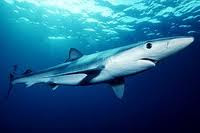This is what gave the great white shark it's terrible reputation and what caused it to strike fear into the hearts of any person from diver to doctor, from surfer to businessman. Yet this supposed man-killer is not what it is said to be. In fact, this 'cold blooded killer' has killed less humans than humans have killed great white sharks. We humans have less to fear from it than it has to fear from us.
The reason we fear this fascinating creature is mainly down to one film. Jaws. It featured a single great white shark terrorizing a seaside town, biting boats in half and killing swimmers. True, sometimes a great white shark will attack a human but only if it has been provoked by that person. Or if it was pregnant and the person came too close for comfort. But mainly it is a mistake. Sharks, great whites particularly have bad eyesight and to them, a swimmer or surfer looks quite like a dolphin or a seal and it will launch an attack. Normally if it realizes it's mistake it will let go and swim away.
 |
| A surfer's silhouette from beneath. |
 |
| A seal's silhouette from beneath. |
See the similarities? For a great white shark, it is exactly the same.
Great white sharks are clever and curious, if they see bait on a line, they will cruise around it until they think it is safe to eat it they have electrical sensors that guide them to food, and other objects such as diving cages. They will open their mouths, bare their teeth, lift up the skin above their top jaw and lunge forward. All that takes about a second.
In some amazing cases, great white sharks will allow themselves to be petted by humans. Valerie Taylor managed to get a great white shark to poke it's head out of the water, eat a dead fish calmly and let her pat it's nose before telling it to swim away (which it did). What a miracle. But in that moment, the world was shown that great white sharks weren't monsters, but, intelligent, fascinating and misunderstood creatures just waiting to be learnt about.
 |
| A great white shark drifting peacefully in the Pacific Ocean. |










